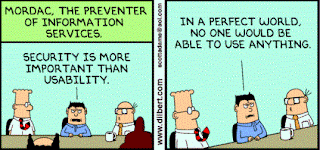 |
| Anonymous employee *source: Google images* |
Revealing
systems of control and power
In all organizations there is varying levels of power, control,
and politics. It can affect the work environment, productivity, employee satisfaction and
other aspects of an organization.
I conducted an interview with
an employee who's company is the epitomy of "unfair
and unnecessary power structures, procedures, and communication
practices" (Gallagher, Erin. Critical
Approaches, PPT slides, 2013)
To respect the employee and the organization, both will
remain anonymous through out this blog entry. I will refer to the
employee as [D] and his boss as [^^] and myself as [LT].
[LT] How is power distributed throughout the organization?
[D]: It's held by executive level
[LT]: How much voice does the average employee have?
[D]: "There's little room to voice one's opinion. Even if we voice our opinions, it's not heard."
 |
| *image source dilbert.com* |
 |
| *image source dilbert.com* |
[D]: HA!
| *image source dilbert.com* |
[LT]: I see.... very discouraging, unsupportive, and inhibiting.
[D]: Pretty much. They think we are all idiots. We're micromanaged and given senseless tasks that we cannot accomplish due to a lack of support, information, resources, and proper approvals to get anything done.
[LT]: So the leadership is holding you back?
[D]: It's a never ending cycle...
| *image source dilbert.com* |
[LT]: Would you describe the relationship with your manager positive or negative?
[D]: well.... it's more the latter than the former."
| Simple Power *image source dilbert.com* |
[LT]: What are some policies and that are hindering your productivity?
[D]: "What isn't hindering my productivity? The constant procedures and policies are utter non-sense, but it keeps the power in upper-management's hands. As an employee, I don't have the ability to make simple decisions, and hence cannot complete my job in a timely or productive manner."
| An example of bureaucratic control. *image source dilbert.com* |
[LT]: Do you at least have the technological support?
 |
| *image source dilbert.com* |
[LT]: Hmm.... certainly sounds like there are varying levels of control.
As organizational communication theories discuss, control comes in four forms of power: Simple, Bureaucratic, Technological, and Concertive.
 |
| Simple power |
Simple power is the use of the authoritative power granted with a position of leadership.
Bureaucratic power is referring to the policies and procedures necessary to follow.
Technological power is the power technology can provide to control one's actions. (i.e. security cameras, password protection codes, security clearances, blocked websites, etc.)
 |
| Bueacratic power |
And finally, Concertive power is control through culture and identification. It's the pressure that co-workers apply to coerce one to follow certain norms and rules (typically established by upper management).
Power and control is necessary.
The question is, as an organization how can you use power and control without
inhibiting productivity and demoralizing employees?
There is no answer, only self analysis.
As an employee you must realize
you have a choice. That is your power. You have the choice to be submissive to
the powers/control around you. You have a choice to stay at that establishment.
Of course your choice will have consequences, so what are you willing to
accept? What is it that corporate wants? Why are they employing these forms of
power and control? If you know the answers to these you be begin to find other
solutions. You can learn to be an influencer to change the way things are done.
Consider the book How
to Win Friends and Influences People by
Dan Carnegie, as well as other persuasion
and influence techniques.
As a corporation, review what
are the forms of power/control being exercised? What is their purpose? How is
it affecting employee morale and productivity? How much extra stress and work
in placed on you to maintain this power? How much control is really required?
Rationalize this. How much can be dispersed to employees so they are empowered?
What needs to be communicated and what training is necessary so that they are
empowered? How can you monitor the quality and security still so you can
release more power/control without inhibiting productivity or morale?
It's all a balancing act. If
power and control is misused it can have detrimental effects, like it does with
our guest employee [D]. It needs to be used responsibly and appropriately. If
any cases sound too similar to the interview had....well...it's time to take a
critical approach to the current establishment's power structure.
Love it! Great job including perfect examples of the different forms of control. You've got a good grasp on what the critical approach is all about. Keep up the good work!
ReplyDelete